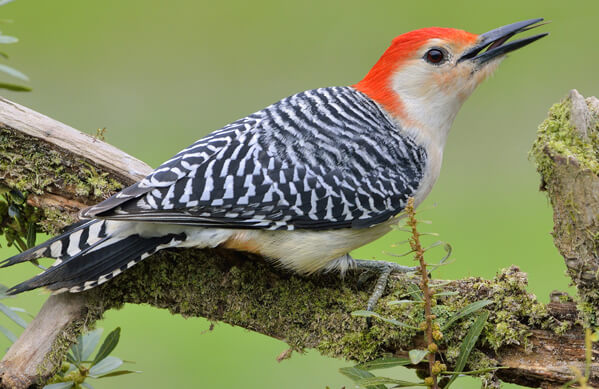Woodpeckers in Florida Population: Species Summary and Conservation
Wiki Article
Woodpeckers: A Comprehensive Guide to Recognizing These One-of-a-kind Birds
Woodpeckers, with their unique behaviors and physical qualities, have actually long mesmerized the interest of ornithologists and nature lovers alike. As we check out the intricate anatomy, varied species, and eco-friendly relevance of woodpeckers, a much deeper recognition for these special birds and the mysteries they hold unfolds.
Woodpeckers' Drumming Behavior
Woodpeckers display a rhythmic and specific drumming behavior that offers various necessary features in their lives. This actions is largely connected with interaction, region defense, and foraging. The distinctive drumming noise is produced by the rapid pecking of their beaks versus difficult surfaces such as tree trunks, branches, or also steel things.Communication is a crucial facet of woodpecker behavior, and drumming plays a significant function in this process. Woodpeckers make use of drumming to develop their presence, attract mates, and maintain call with their partners and spawn. The frequency, strength, and duration of drumming series communicate specific messages to various other woodpeckers in the location.
Along with interaction, woodpeckers utilize drumming habits for area protection. Woodpeckers in Florida. The loud and repetitive drumming acts as an alerting to prospective burglars, indicating that the location is already declared. By establishing their area through drumming, woodpeckers decrease the chance of conflicts over useful sources such as food and nesting sites
Moreover, woodpeckers likewise utilize drumming as a foraging method. The balanced pecking assists them situate bugs hiding beneath the bark of trees by developing resonances that disrupt the prey's camouflage. This behavior showcases the versatility and ingenuity of woodpeckers in using their drumming skills for numerous necessary objectives.
One-of-a-kind Adaptations for Tree Climbing
Having actually grasped the art of drumming to communicate, protect territory, and forage, woodpeckers have developed unique adjustments that facilitate their remarkable climbing up capabilities in their arboreal environments. One vital adjustment is their specific feet. Woodpeckers have zygodactyl feet, with 2 toes directing ahead and two toes pointing in reverse. This setup gives a solid grasp on the vertical surface areas of trees, allowing them to cling effortlessly while foraging for insects or drumming. Furthermore, woodpeckers possess tight tail feathers that function as a prop to support their bodies as they climb up. These tail feathers offer security and equilibrium, allowing woodpeckers to steer up tree trunks with accuracy and dexterity.Furthermore, woodpeckers have effective neck muscle mass and an one-of-a-kind skull structure that help in their climbing capacities. Their strong neck muscular tissues permit them to swiftly eat tree bark without experiencing whiplash, while their thick skull and tiny mind serve as shock absorbers, shielding them from the impact of repeated drumming. These adjustments jointly enable woodpeckers to navigate the upright globe of trees with performance and grace.

Role of Woodpeckers in Environments
Playing a pivotal duty in woodland environments, woodpeckers add dramatically to the balance and health of their environments through their one-of-a-kind habits and communications with other have a peek at this website types. Among the vital ecological features of woodpeckers is their duty in managing insect populations. By foraging for insects under discover here the bark of trees, woodpeckers help regulate parasite populaces, protecting against break outs that can hurt the overall health and wellness of the woodland. Additionally, woodpeckers create cavities in trees that offer as vital nesting sites for a selection of other bird types, promoting biodiversity within the environment.Moreover, the drumming and vocalizations of woodpeckers play a vital role in communication and territory establishment. These noises not just offer to attract friends but likewise assist define boundaries in between various woodpecker regions, decreasing disputes and advertising a harmonious conjunction within the forest neighborhood. Generally, the visibility of woodpeckers in forest ecosystems highlights their significance as keystone types, affecting the characteristics and operating of these habitats in complex methods.
Makeup: Specialized Beaks and Feet
In the intricate internet of woodland environments, the specialized beaks and feet of woodpeckers are essential adaptations that allow them to satisfy their crucial ecological functions. Woodpeckers have distinct physiological functions that are especially made to aid them in their foraging and nesting actions.The most distinctive attribute of woodpeckers is their solid, chisel-shaped beaks. These beaks are completely adjusted for drilling right into wood to reveal bugs, larvae, and sap concealed beneath the bark of trees. The strong muscle mass and durable framework of their beaks enable woodpeckers to eat a price of up to 20 times per second without triggering damages to their heads.
Additionally, woodpeckers have specialized feet that help in their acrobatic climbing up abilities. Their feet have 2 toes directing ahead and two toes pointing in reverse, offering a solid hold on upright surface areas (Woodpeckers in Florida). This unique foot setup, together with stiff tail plumes that function as an encouraging prop, enables woodpeckers to stick to tree trunks and branches with simplicity while they search for food or dig deep into nesting navigate to this website cavities
Woodpecker Variety Variety
Woodpeckers are a diverse group of birds located across numerous environments worldwide, with over 200 well-known varieties displaying adjustments to various settings. Woodpeckers have evolved to populate a range of settings, from forests and woodlands to meadows and deserts, each presenting special obstacles that have actually affected the advancement of unique woodpecker species.These adaptations enable woodpeckers to forage efficiently in their respective habitats, minimizing competitors amongst species and advertising niche distinction. Furthermore, geographical seclusion and historic factors have played a duty in forming the circulation and variety of woodpecker varieties, leading to the large array of specialized adjustments seen in these remarkable birds.

Conclusion
In final thought, woodpeckers are fascinating birds that show special drumming habits, specialized adjustments for tree climbing, and play crucial functions in ecological communities. With a varied range of woodpecker types found worldwide, these birds are necessary for preserving the health and equilibrium of forests and woodlands.Report this wiki page